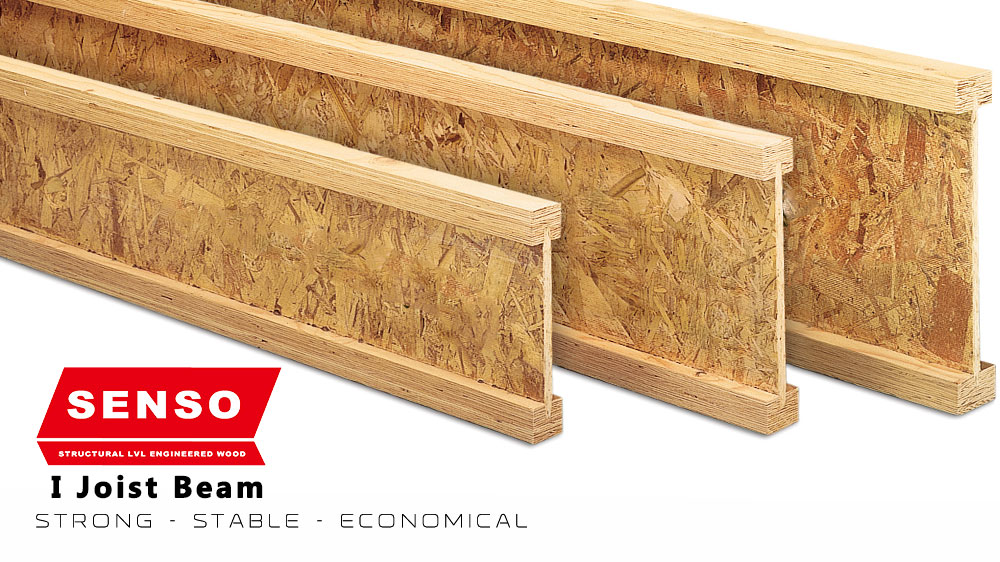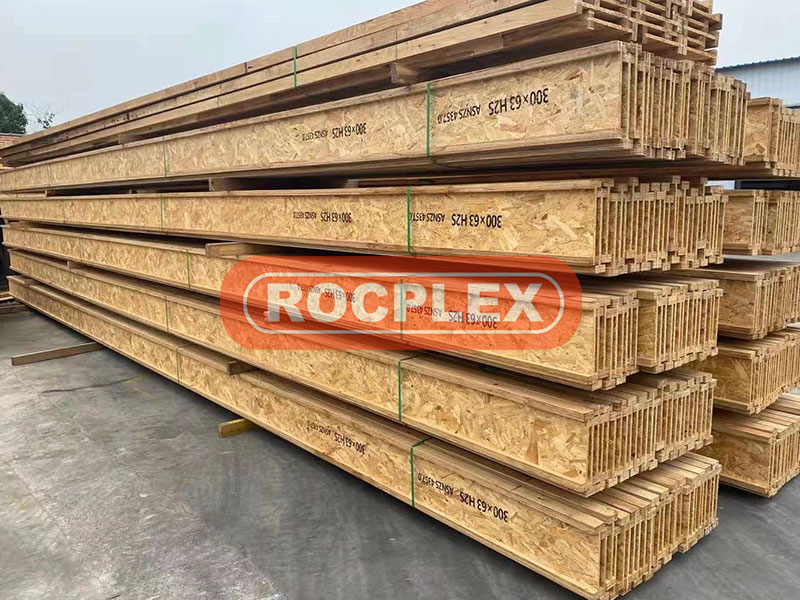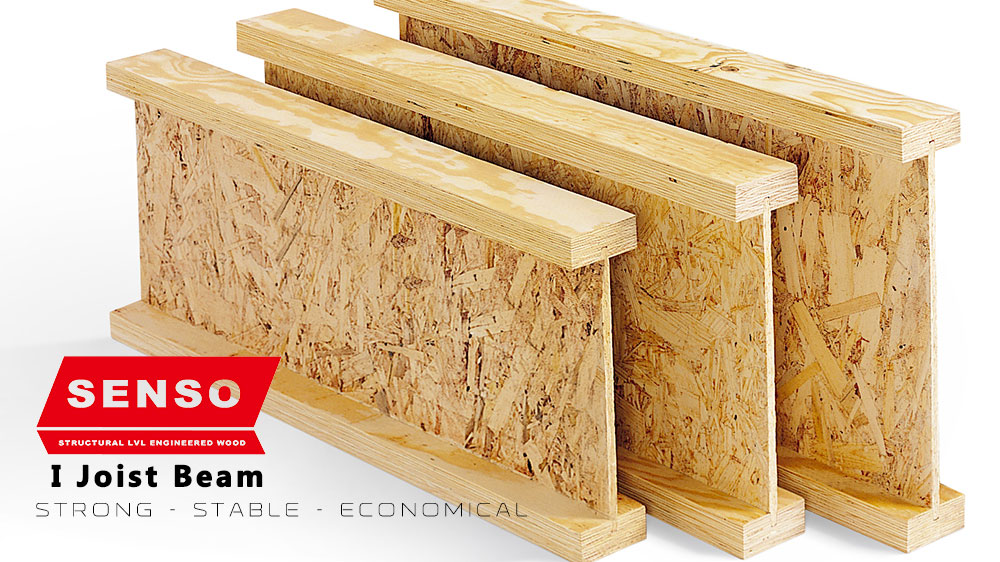What is a Wood I Beam?
A wood I beam, also known as an engineered I-joist, is a structural component used in construction to support floors and roofs. It is constructed from LVL wood, which stands for laminated veneer lumber, combined with oriented strand board (OSB) or plywood. The result is a lightweight yet incredibly strong beam that can span long distances without the need for additional support. This makes wood I beams an excellent choice for both residential and commercial building projects. LVL beams, in particular, are known for their uniformity, strength, and reliability, making them a preferred option for builders and architects looking for efficiency and performance.
A wood I beam is designed to mimic the traditional steel I-beam. It has flanges on the top and bottom with a web in between. The flanges are typically made from LVL lumber. LVL is created by bonding thin wood veneers together under heat and pressure. The web is usually made from OSB or plywood, providing stability and rigidity. This combination of materials results in a beam that is not only strong but also lightweight and easy to handle.
The Advantages of Wood I Beams
Strength and Stability
Wood I beams offer remarkable strength and stability, making them suitable for a variety of structural applications. The use of LVL wood in the flanges gives the beams a high load-bearing capacity. This allows them to support heavy weights without bending or warping. The strength is further enhanced by the stability of the OSB or plywood web. The web distributes loads evenly and reduces the risk of structural failure.
Lightweight and Easy to Handle
One of the key benefits of wood I beams is their lightweight nature. Despite their strength, these beams are significantly lighter than traditional solid wood or steel beams, making them easier to transport and install. This ease of handling reduces labor costs and speeds up the construction process, contributing to overall project efficiency.
Versatility in Applications
Wood I beams are incredibly versatile and can be used in a wide range of applications. They are commonly used in floor and roof systems, providing a stable and reliable support structure. Additionally, wood I beams can be used in wall framing and other structural components, offering flexibility for builders and architects. The ability to span long distances without the need for intermediate supports makes wood I beams an ideal choice for open floor plans and large spaces.
The Manufacturing Process of Wood I Beams
Selection of Raw Materials
The manufacturing process of wood I beams begins with the selection of high-quality raw materials. LVL wood is chosen for the flanges due to its strength and uniformity. The veneers used in LVL are carefully selected and graded to ensure consistency and performance. For the web, OSB or plywood is typically used, providing a stable and rigid core for the beam.
Assembly and Bonding
The assembly process involves bonding the LVL flanges to the OSB or plywood web using high-strength adhesives. This bonding process is critical to the performance of the wood I beam, as it ensures that the components work together as a single, unified structure. The adhesives used are designed to withstand heavy loads and resist environmental factors such as moisture and temperature changes.
Pressing and Finishing
Once the components are bonded, the wood I beams are pressed to ensure a strong and uniform connection. This pressing process applies heat and pressure to the assembly, curing the adhesives and creating a solid, durable beam. After pressing, the beams are cut to length and finished to meet specific project requirements. Quality control measures are implemented throughout the process to ensure that each beam meets industry standards for performance and reliability.
Applications of Wood I Beams
Residential Construction
In residential construction, wood I beams are commonly used for floor joists and roof rafters. Their strength and stability make them ideal for supporting floors and roofs, providing a solid foundation for the home. The ability to span long distances without the need for additional supports allows for open floor plans and spacious living areas, enhancing the overall design and functionality of the home.
Commercial and Industrial Buildings
Wood I beams are also widely used in commercial and industrial buildings. Their high load-bearing capacity and stability make them suitable for a variety of structural applications, from supporting floors and roofs to framing walls and partitions. The versatility and efficiency of wood I beams make them a valuable component in large-scale construction projects, where strength and reliability are paramount.
Infrastructure Projects
In infrastructure projects, wood I beams can be used for bridges, overpasses, and other structural components. Their lightweight nature and high strength make them an excellent choice for these applications, providing a reliable and durable solution. The use of wood I beams in infrastructure projects demonstrates their versatility and effectiveness in a wide range of construction contexts.
Innovations in Wood I Beam Technology
Advanced Adhesives
Recent advancements in adhesive technology have further enhanced the performance of wood I beams. Modern adhesives are designed to create stronger bonds between the LVL flanges and the OSB or plywood web, improving the overall strength and durability of the beams. These advancements also contribute to the environmental sustainability of wood I beams, as many new adhesives are formulated to be more eco-friendly.
Customizable Solutions
Manufacturers are increasingly offering customizable wood I beam solutions to meet the specific needs of different projects. From varying flange widths and web thicknesses to tailored lengths, wood I beams can be produced to precise specifications. This customization allows builders to select the perfect wood I beam for their particular needs, enhancing both efficiency and effectiveness.
Integration with Digital Design Tools
The integration of wood I beams with digital design tools is another exciting development in the industry. Builders and architects can now use software to model and simulate the performance of wood I beams in their projects. This capability allows for more accurate planning and execution, reducing the risk of errors and enhancing the overall quality of construction.
Environmental Benefits of Wood I Beams
Sustainable Forestry Practices
The production of wood I beams often involves sustainable forestry practices, ensuring that the timber used comes from responsibly managed forests. This commitment to sustainability helps preserve natural resources and supports the long-term health of forest ecosystems. By choosing wood I beams, builders and architects can contribute to more sustainable construction practices.
Efficient Use of Timber Resources
The manufacturing process of wood I beams makes efficient use of timber resources, reducing waste compared to traditional lumber production. The use of LVL wood in the flanges and OSB or plywood in the web ensures that the maximum amount of timber is utilized, minimizing the environmental impact. This efficiency is a key factor in the sustainability of wood I beams.
Long-Term Durability
Wood I beams are designed to last, providing long-term durability and reducing the need for frequent repairs or replacements. This longevity contributes to the overall sustainability of construction projects, as fewer resources are needed to maintain and replace structural components over time. The durability of wood I beams makes them a responsible choice for environmentally conscious builders.
Addressing Common Misconceptions About Wood I Beams
Wood I Beams vs. Traditional Lumber
A prevalent misconception is that wood I beams are just an expensive alternative to traditional lumber. In reality, the superior strength, consistency, and performance of wood I beams make them a more cost-effective solution in the long term. Traditional lumber can have significant variability and defects, such as knots and warping, which can compromise structural integrity. In contrast, wood I beams, with their engineered construction, provide predictable performance and greater reliability, reducing maintenance and repair costs over the lifespan of the building.
Wood I Beams and LVL Lumber
Another common misunderstanding is confusing wood I beams with LVL lumber. While both are engineered wood products, they serve different purposes. LVL lumber is made by bonding layers of wood veneers, creating a product that is exceptionally strong and uniform. LVL is often used for beams, headers, and other structural applications. On the other hand, wood I beams combine LVL lumber for the flanges and OSB or plywood for the web, creating a product that is designed to span long distances with minimal support, making it ideal for floor and roof joists.
Environmental Impact
Some may believe that the production of wood I beams has a negative environmental impact. However, the reality is that wood I beams are often produced using sustainable forestry practices and environmentally friendly adhesives. The efficient use of timber resources and the long-term durability of wood I beams contribute to their sustainability, making them an eco-friendly choice for modern construction. By utilizing renewable wood resources and minimizing waste, wood I beams help reduce the overall environmental footprint of building projects.
The Role of Wood I Beams in Modern Architecture
Supporting Innovative Designs
Wood I beams play a crucial role in supporting innovative architectural designs. Their strength and versatility allow architects to push the boundaries of traditional design, creating structures that are both functional and aesthetically pleasing. Wood I beams enable the creation of open, airy spaces with long spans, which are often sought after in contemporary architecture. This ability to support large, open areas without intermediate supports opens up new possibilities for creative and flexible designs.
Enhancing Aesthetic Appeal
In addition to their structural benefits, wood I beams also enhance the aesthetic appeal of buildings. Exposed wood I beams can add a modern, industrial look to interior spaces, blending functionality with design aesthetics. The clean lines and uniform appearance of wood I beams make them an attractive choice for both residential and commercial buildings. By incorporating wood I beams into their designs, architects can achieve a balance between strength and beauty, creating visually striking structures.
Sustainable Design Solutions
Incorporating wood I beams into building designs supports sustainable design solutions. The material’s efficient use of timber resources and its environmental benefits make it a valuable component of green building practices. By choosing wood I beams, architects can create structures that are not only beautiful and functional but also environmentally responsible. This commitment to sustainability is increasingly important in the construction industry, where there is a growing emphasis on reducing the environmental impact of building projects.
The Future of Wood I Beams
Growing Demand for Sustainable Building Materials
As the demand for sustainable building materials continues to grow, wood I beams are well-positioned to play a significant role in the green building movement. Their efficient use of timber resources and eco-friendly manufacturing processes make them an ideal choice for environmentally conscious projects. The future of wood I beams looks promising as more builders and architects recognize their benefits and incorporate them into their designs. This trend is likely to continue as sustainability becomes a central focus in the construction industry.
Expanding Applications
The versatility of wood I beams means that their applications are continually expanding. From residential homes to commercial buildings and infrastructure projects, wood I beams are being used in an increasingly diverse range of projects. This trend is likely to continue as the construction industry seeks innovative solutions to meet the challenges of modern building. The adaptability of wood I beams ensures that they can meet the evolving needs of the industry, making them a valuable asset in various construction contexts.
Ongoing Research and Development
Ongoing research and development efforts are focused on further enhancing the properties of wood I beams. Innovations in wood science and engineering are advancing wood I beam products. New developments improve their performance characteristics. These advancements keep wood I beams at the forefront of construction technology. Builders can rely on these beams as top-quality materials for their projects. Continued investment in research and development drives the evolution of wood I beams. This ensures they will meet the future demands of the construction industry.
Wood I Beam Transforming Construction Industry
Wood I beams are revolutionizing the construction industry with their strength, efficiency, and sustainability. As builders and architects continue to seek innovative and effective building materials, wood I beams stand out as a superior choice for a wide range of applications. From residential homes to commercial buildings and infrastructure projects, the benefits of wood I beams are undeniable. With ongoing advancements in technology and a growing focus on sustainability, the future of wood I beams looks promising, ensuring they will remain a vital component of modern construction for years to come.
Post time: Sep-28-2024




